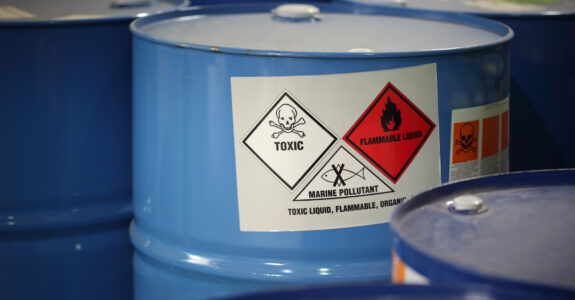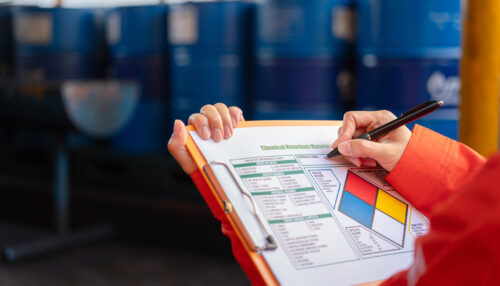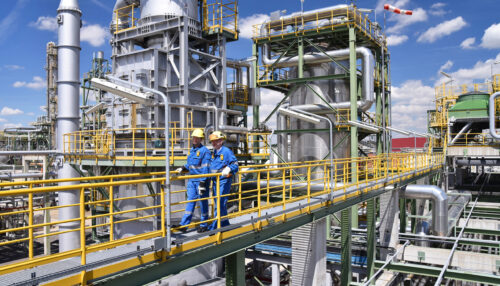
Hazard Communication in Transition: Key GHS Updates Every Business Should Plan For
August 26, 2025
By: Michael Morrisson
The United Nations Globally Harmonized System of Classification and Labelling of Chemicals (GHS) is an international framework designed to ensure consistent communication about chemical hazards across countries and industries. First adopted in 2003, the GHS establishes standardized criteria for classifying chemicals by their health, physical, and environmental hazards, and provides globally recognized formats for labels and Safety Data Sheets (SDS).
The system improves safety by making chemical hazard information clearer, more consistent, and easier to understand—whether a worker is handling chemicals in the U.S., the EU, or Asia. By harmonizing classifications and labels, GHS reduces confusion, facilitates international trade, and helps protect workers, consumers, and the environment from chemical-related risks.
The GHS framework keeps evolving, and regulators in major markets are now updating their rules to track newer GHS editions. If you author safety data sheets (SDSs), relabel products, or run a HazCom program, the next 12–36 months include real deadlines.
The big picture: What changed in GHS itself?
UN GHS Revisions 8–10 (2019–2023) refined hazard classes/criteria and label guidance. Notable themes include:
- Flammable gases are now split into Category 1A (includes pyrophoric and chemically unstable gases) and Category 1B, clarifying how the most hazardous gases are communicated.
- Aerosols have been renamed from “flammable aerosols” to “aerosols” with a new Category 3 for non-flammable aerosols; aerosols are not classified as “gases under pressure” just because they’re in a can.
- Desensitized explosives have been added as a distinct hazard class, bringing consistent labeling and statements.
- Small-package labeling examples (e.g., fold-out labels) and further rationalized precautionary statements are required to make tiny containers more manageable.
- Later editions (Rev. 9–10) include ongoing housekeeping regarding procedures and non-animal test methods.
Bottom line: The UN model evolved. Now countries are locking those changes into law at different speeds.
United States: OSHA’s 2024 HazCom Final Rule
OSHA published its HazCom update on May 20, 2024; it took effect July 19, 2024 and aligns primarily with GHS Rev. 7 (plus select Rev. 8 pieces).
What changed for classification & labels
- Flammable gases: Categories are now split into 1A/1B, with pyrophoric and chemically unstable gases called out in 1A. Aerosols now include a non-flammable Category 3. Desensitized explosives have been added. Expect updated hazard statements/pictograms to match.
- Small containers: OSHA now explicitly allows fold-out/pull-out labels and abbreviated info on the immediate container when space is limited. When a container is ≤3 mL, it may allow identifier-only labels, with full information on the outer package and “keep in outer package when not in use”.
- “Released for shipment” relief: If a container was already labeled and released for shipment, manufacturers do not have to relabel upon new hazard information but must provide updated labels with the next shipment and update SDSs.
What changed for SDSs
- Section 3, Composition: You may withhold concentration or concentration range as a trade secret by using OSHA’s prescribed ranges (e.g., 0.1–1%, 1–5%, 5–10%, etc.).
- Section 9, Physical and Chemical Properties: This section has been updated to align with GHS Rev. 7 and now includes particle characteristics (e.g., particle-size distribution) when readily available. This is especially relevant for powders/nanomaterials.
- Clarifications to Section 14 coverage, precautionary statements, and ordering/terminology to better mirror GHS.
U.S. compliance dates
- For chemical manufacturers, importers, and distributors:
- Substances: January 19, 2026 for SDS and shipped-container labels
- Mixtures: July 19, 2027 for SDS and shipped-container labels
- For employers (workplace labeling, written program, training):
- Substances: July 20, 2026
- Mixtures: January 19, 2028
You may comply early. Dual compliance with the prior HCS was allowed during the transition.
Canada: Workplace Hazardous Materials Information System (WHMIS) 2022 – Hazardous Products Regulations (HPR) Amendments
Canada amended the HPR to align with GHS Rev. 7 (plus certain Rev. 8 elements). The amendments came into force December 15, 2022, with a transition period ending December 14/15, 2025 for suppliers to update classifications, SDSs, and labels.
Highlights:
- New physical hazard class: “Chemicals Under Pressure” (Rev. 8 concept) with categories and required label elements.
- SDS tweaks: Updates focus on Section 9 physical properties and Section 14 transport information alignment.
- Small containers: Long-standing HPR flexibilities continue—≤100 mL can use reduced elements; ≤3 mL can be designed so the label is removable at use if it interferes with normal handling (outer packaging must stay fully labeled).
European Union: Classification, Labelling, and Packaging (CLP) changes on top of GHS
The EU’s CLP Regulation now includes new hazard classes for:
- Endocrine disruptors (human health and environment),
- PBT/vPvB, and
- PMT/vPvM (persistent, mobile, toxic).
Key dates for the new EU hazard classes (Reg. (EU) 2023/707):
- Substances: required by May 1, 2025 (existing substances on the market get extra time to November 1, 2026).
- Mixtures: required by May 1, 2026 (existing mixtures on the market get extra time to May 1, 2028).
The EU also issued a revised CLP in December 2024 to modernize labeling (e.g., online sales and complex mixtures), which will progressively apply across the single market. Expect label content/format nuances on top of GHS baselines.
What this means for you
1) Safety Data Sheets (SDSs)
- Update physical-property fields in Section 9 (e.g., particle characteristics) and ensure your fields align with GHS Rev. 7 ordering and terminology where required. (OSHA; HPR)
- Trade secrets (U.S.): If withholding ingredient concentration or range, use OSHA’s prescribed ranges in Section 3. Review internal confidentiality policies to match.
- EU SDSs: Recheck classification logic against the new CLP hazard classes; your Section 2 will change if ED, PBT/vPvB, or PMT/vPvM criteria are met.
2) Shipped-container labeling
- U.S.: Refresh labels for flammable gases (1A/1B), aerosols (incl. Cat. 3), and desensitized explosives. Plan small-container strategies.
- Release-for-shipment (U.S.): No mid-stream relabeling of already-shipped stock; send updated labels with the next shipment and update SDSs.
- Canada: Ensure HPR label sets reflect Chemicals Under Pressure and any other amended classes.
- EU: If your products meet new CLP hazard classes, expect new hazard statements and, in some cases, different label combinations or supplemental info under CLP.
3) Workplace labeling & HazCom programs
- U.S. employers must update alternative workplace labels, the written HazCom program, and training to the new rule by the employer deadlines (July 20, 2026 for substances; Jan 19, 2028 for mixtures). The base workplace-label elements are unchanged (product identifier, hazard information, etc.), but your content and training may change due to the new classifications.
- Canada/EU: Update internal labels and training materials to match the supplier label and SDS changes you receive under HPR/CLP. (Canada transition ends Dec 14/15, 2025; EU timelines above.)
Simplify SDS updates across markets
GHS continues to converge globally, but the implementation is local. OSHA’s 2024 update (Rev. 7+), Canada’s WHMIS 2022, and the EU’s CLP additions (ED/PBT/PMT) will change how you classify, what your SDSs say, and what appears on both shipped and workplace labels—on firm timelines. Planning now will keep you out of the crunch later.
At Montrose, we help companies cut through the complexity of evolving GHS, WHMIS, and CLP requirements. From assessing your product inventory and updating classifications to revising Safety Data Sheets, labels, and workplace training programs, our team ensures your rollout stays aligned with regional deadlines in the U.S., Canada, and EU. With clear planning and efficient execution, we make compliance easier—so you can focus on your business with confidence.
Contact us today to learn how we can support your SDS updates and keep you ahead of upcoming regulatory changes.
 Michael Morrisson
Michael Morrisson
EHS Consultant II
Mr. Morrisson is an experienced EHS professional with several years of auditing experience in various industries while working at Montrose, including railroad, oil and gas, food and beverage manufacturing, and several PSM-covered facilities. Mr. Morrisson has served as lead auditor for over 50 audits, demonstrating a strong expertise in regulatory compliance, resulting in improved environmental practices and compliance strategies for audited clients. Mr. Morrisson also has experience building EHS programs for these companies, ranging from general compliance programs to certification programs such as ISO 14001. Prior to his time at Montrose, Mr. Morrisson worked in the private sector, both managing and auditing various environmental programs including Air, Stormwater, Hazardous waste, PWS, EPCRA, and Wastewater.




